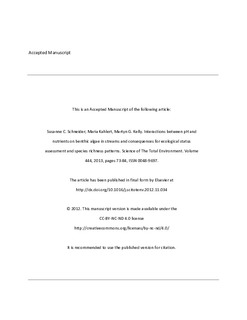| dc.contributor.author | Schneider, Susanne Claudia | |
| dc.contributor.author | Kahlert, Maria | |
| dc.contributor.author | Kelly, Martyn G. | |
| dc.date.accessioned | 2018-11-05T13:16:51Z | |
| dc.date.available | 2018-11-05T13:16:51Z | |
| dc.date.created | 2013-06-15T15:13:17Z | |
| dc.date.issued | 2013 | |
| dc.identifier.citation | Science of the Total Environment. 2013, 444, 73-84. | nb_NO |
| dc.identifier.issn | 0048-9697 | |
| dc.identifier.uri | http://hdl.handle.net/11250/2571005 | |
| dc.description.abstract | Eutrophication and acidification are among the major stressors on freshwater ecosystems in northern Europe and North America, but possible consequences of interactions between pH and nutrients on ecological status assessment and species richness patterns have not previously been assessed. Using data from 52 river sites throughout Norway, we investigated the combined effects of pH and nutrients on benthic algae assemblages, specifically 1) taxa-specific couplings between nutrient and acidity traits, 2) the degree of consistency between different biotic indices, separately for nutrients and acid conditions, 3) the impact of pH on nutrient indices and phosphorus on indices of acid conditions, and 4) the impact of pH and phosphorus supply on diatom and non-diatom taxon richness. We found that 1) acid-tolerant taxa are generally associated with nutrient-poor conditions, with only a few exceptions; this is probably more a consequence of habitat availability than reflecting true ecological niches; 2) correlation coefficients between nutrient indices and TP, as well as acid conditions indices and pH were barely affected when the confounding factor was removed; 3) the association of acid-tolerant taxa with nutrient-poor conditions means that the lowest possible nutrient index at a site, as indicated by benthic algae, is lower at acid than at circumneutral sites. Although this may be an artifact of the datasets from which taxa-specific indicator values were derived, it could lead to a drift in nutrient indices with recovery from acidification; 4) the response of non-diatom taxon richness follows a complex pattern with a synergistic interaction between nutrient supply and pH. In contrast, diatom richness follows a simple additive pattern; this suggests structural differences between diatoms and non-diatom benthic algae in their response to nutrient supply and pH; diatom taxon richness tended to increase with nutrient supply, while non-diatom richness decreased. | nb_NO |
| dc.language.iso | eng | nb_NO |
| dc.publisher | Elsevier | nb_NO |
| dc.rights | Attribution-NonCommercial-NoDerivatives 4.0 Internasjonal | * |
| dc.rights.uri | http://creativecommons.org/licenses/by-nc-nd/4.0/deed.no | * |
| dc.title | Interactions between pH and nutrients on benthic algae in streams and consequences for ecological status assessment and species richness patterns | nb_NO |
| dc.title.alternative | Interactions between pH and nutrients on benthic algae in streams and consequences for ecological status assessment and species richness patterns | nb_NO |
| dc.type | Journal article | nb_NO |
| dc.type | Peer reviewed | nb_NO |
| dc.description.version | acceptedVersion | nb_NO |
| dc.source.pagenumber | 73-84 | nb_NO |
| dc.source.volume | 444 | nb_NO |
| dc.source.journal | Science of the Total Environment | nb_NO |
| dc.identifier.doi | 10.1016/j.scitotenv.2012.11.034 | |
| dc.identifier.cristin | 1034422 | |
| dc.relation.project | Norges forskningsråd: 184002 | nb_NO |
| cristin.unitcode | 7464,30,19,0 | |
| cristin.unitname | Ferskvannsøkologi | |
| cristin.ispublished | true | |
| cristin.fulltext | postprint | |
| cristin.qualitycode | 2 | |

